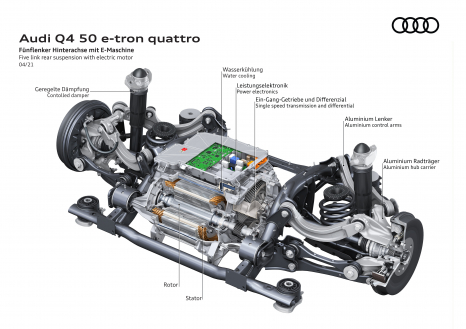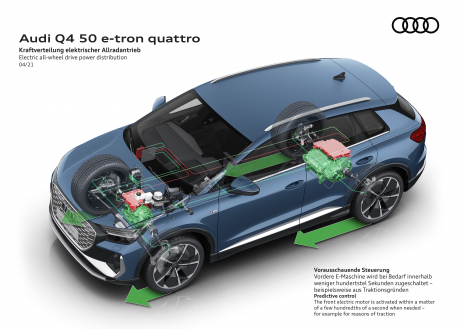Audi Q4 Sportback e-tron – Elektric quattro
Intelligent control: electric all-wheel drive The electric all-wheel drive in the Q4 e-tron top models** has an asynchronous motor (ASM) on the front wheels that can rev at up to 14,000 rpm. It is installed coaxially and has combined cooling with coolant and oil. The principal advantages of the ASM are its short-term overload capacity and the minimal drag losses when it is inactive – these are important because the front motor does not contribute to the drive in the majority of driving situations for reasons of efficiency. Its one-speed transmission has a ratio of 10.0:1, and the whole unit comes in at around 60 kilograms on the scales.
In the electric all-wheel drive, the two electric motors work together with maximum efficiency. During moderate driving, the PSM in the rear works the drive on its own for reasons to do with efficiency and traction. When the driver asks for more power than it can offer, the front electric motor is activated – in just a few hundredths of a second. The same happens predictively when driving on slippery roads or cornering at high speed even before the car starts to noticeably understeer or oversteer. The wheel-selective torque control, a software function, rounds off the work of the electric all-wheel drive with finely metered brake interventions at the wheels under a reduced load on the inside of a curve.
The electric all-wheel drive shows off its strengths very clearly at low coefficients of friction, such as on very wet or snow-covered roads or on a loose surface. High stability, sporty handling, and secure grip give the Q4 e-tron quattro** a crucial advantage. Following its debut in the Audi e-tron, the electric quattro now makes its way into the compact class.
For maximum efficiency: coast or recuperate?
When the Audi Q4 e-tron is on the move in gear D (drive) and the driver takes their foot off the accelerator pedal, the drive switches to coasting mode. Both electric motors – or the rear motor in the rear-wheel drive models – run freely and largely without energy. Coasting takes priority, because it is the most efficient. If the driver prefers recuperation, however, they have a variety of options for this. In gear B (brake), the drive almost always recuperates when coasting but not when the car is at a standstill. The limit is hit at 0.15 g of deceleration. If “dynamic” mode is set in the optional Audi drive select dynamic handling system (standard in the Sportback), recuperation also takes place in gear D but at a slightly weaker rate than in B.
The optional shift paddles on the steering wheel enable the driver to select three different manual recuperation levels in position D – 0.06 g, 0.10 g, and 0.15 g. The driver can also choose automatic recuperation in the MMI system. When the car enters a zone that enforces a lower speed or when it comes up behind a slower car in front, the drive management system attempts to reduce speed by coasting. If the distance available is too short, it switches to coasting recuperation up to a maximum of 0.10 g. For automatic recuperation to cut in, the predictive efficiency assist system must be activated.
When braking, the PSM at the rear alone performs the deceleration in the majority of everyday driving situations. The quattro models** can brake electrically at up to almost 0.3 g, equivalent to a recuperation performance of up to 145 kW. The electric brake booster only activates the hydraulic wheel brakes as well if greater deceleration is required. The transition is almost unnoticeable, and recuperation remains active almost until the vehicle is at a standstill. The quattro models prioritize recuperation on the rear axle but also use the front electric motor in a few situations.
* Information on electric power consumption and CO2 emissions figures given in ranges depend on the equipment selected for the vehicle.
** The collective fuel/electric power consumption values for all models named and available on the German market can be found in the list provided at the end of this press release.
Audi Q4 35 e-tron: Combined electric power consumption in kWh/100 km (62.1 mi)*: 19.1–17.0 (WLTP); 16.7 – 15.8 (NEDC) Combined CO2 emissions in g/km: 0
Audi Q4 Sportback 35 e-tron: Combined electric power consumption in kWh/100 km (62.1 mi)*: 18.6 –16.6 (WLTP); 16.6 – 15.6 (NEDC) Combined CO2 emissions in g/km: 0
Audi Q4 40 e-tron: Combined electric power consumption in kWh/100 km (62.1 mi)*: 19.3–17.3 (WLTP); 17.3 – 16.3 (NEDC) Combined CO2 emissions in g/km: 0
Audi Q4 50 e-tron quattro: Combined electric power consumption in kWh/100 km (62.1 mi)*: 19.9 –17.9 (WLTP); 17.8 – 16.5 (NEDC) Combined CO2 emissions in g/km: 0
Audi Q4 Sportback 50 e-tron quattro: Combined electric power consumption in kWh/100 km (62.1 mi)*: 20.9 –17.6 (WLTP); 17.9 – 16.4 (NEDC) Combined CO2 emissions in g/km: 0
04/2021

